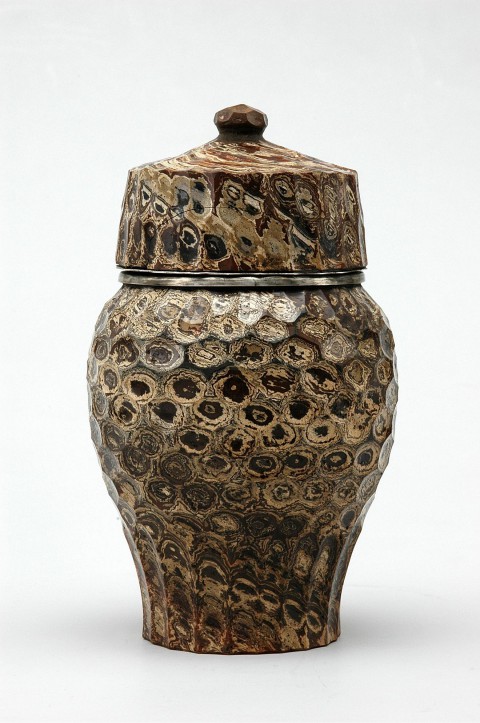Tobacco or tea container, with a cover
karta katalogowa kolekcji
Rzemiosło artystyczne
Johann Friedrich Böttger
Germany, Meissen
About 1711
Stoneware of multi-colour mass, cut, burnished; metal
Ø 10.2 x 17.5 cm
Wil.2616
The appearance in Europe of red stoneware, known at the end of the seventeenth century and the beginning of the eighteenth century as boccaro or “red porcelain”, was associated with attempts at producing the sort of pottery imported together with coffee and tea from Yixing (China). It was commonly held that these fashionable beverages should be drunk only from such receptacles in order to fully appreciate their flavour and aroma. Imitations of the Chinese original were first produced in the Netherlands, and then this skill was transferred to England. Its beginning in Saxony are connected with undertakings to transform metal into gold, a procedure then considered possible. This is what Augustus II expected from his prisoner – the young and talented alchemist Johann Friedrich Böttger, whose experiments led to an entirely different discovery. Thanks to the support of Ehrenfried Walther von Tschirnhaus, chemist and naturalist, and Papst von Ohain, mining councillor from Freiberg, as well as supplies of suitable clay from the region of Meissen, in 1707 the Böttger laboratories produced first “red” and then “white” porcelain (enabling the king to establish in 1710 a manufactory of this fine pottery, at the time unattainable in Europe). Having obtained extremely hard and exceptionally fine stoneware, Böttger tirelessly worked on new variants of its form and decoration, and his ingenuity and inexhaustible laboriousness were the reasons for its enormous diversity.
The Wilanów collection, totalling almost forty examples (the largest such collection in Poland) illustrates the artist’s versatile talents: the production of faithful copies of Chinese porcelain and gold artefacts, modelling small stoneware sculptures, decorating vessels with reliefs, paint and polishing as well as covering them with glaze, silver and gold. His experiments also encompassed the colour of the product – a gamut of reds and browns, with a surface imitating the matte texture of iron or resembling semi-precious stones, obtained from mixing multi-hued clay. The most distinct difference between the Saxon and Chinese earthenware was the fact that the majority of Böttger’s products were subjected to polishing and grinding. Not without reason did he employ in 1710 29 specialists from Dresden and Bohemia (together with nine potters, four goldsmiths, three glazers, two painters and one painter on glass). Böttger described his material as “jasper porcelain” since after skilful tooling the raw material assumed the sheen of jasper or agate. This type of decoration attracted the attention of Stanisław Kostka Potocki, who wrote in his work from 1815: (...) Böttger’s pottery, or as it is known in Saxony, his porcelain has this advantage over the Chinese one that once polished it assumes a lustre. The Wilanów coffee or tea container – with a surface transformed into a net of small bezels reflecting light under various angles – is one of the few multi-coloured examples preserved in world collections. Its uniqueness is additionally enhanced by the fact that only three were decorated with a similar “shell” cut.
Barbara Szelegejd
Polecane

Beginnings of tobacco in Poland
Tobacco came into Poland quietly, one could even say that secretly. We can guess about when it happened based on …

Wilanów Top 15
The Wilanów Top 15 presents the most valuable, extraordinary and beautiful works of art from the Wilanów Palace collection. The exhibits originate from all over the world, from ancient Rome through 17th-century Japan to ateliers of the French masters. Their history reflects the lives and fate of people related to the Wilanów residence. Get acquainted with the exhibits, view and admire them only to rediscover them later in the palace interiors.

















